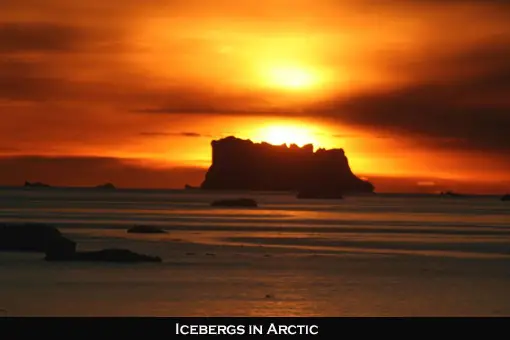Melting Ice and Sea Levels
Each year about 8 mm (0.3 inch) of water from the entire surface of the oceans goes into the Antarctica and Greenland ice sheets as snowfall. If no ice returned to the oceans, sea level would drop 8 mm every year as much of the deposited snow is water originally from the ocean. Although approximately the same amount of water returns to the ocean in icebergs and from ice melting at the edges, scientists do not know which is greater, the ice going in or the ice coming out. The difference between the ice input and output is called the mass balance and is important because it causes changes in global sea level.
The Archimedes’ Principle helps us understand why and how sea levels rise:
Archimedes’ Principle – When an object is completely or partially immersed in a fluid, the fluid exerts an upward force on the object equal to the weight of the fluid displaced by the object.
Firstly, when considering melting ice and sea levels, we need to appreciate that ice is either already floating in the ocean or it is grounded on a landmass.
Because of Archimedes’ Principle, if the ice is already floating in the ocean, the total mass of the ocean and ice remains unchanged even when the ice melts. Dr. Peter Noerdlinger, a professor at St. Mary’s University in Nova Scotia, Canada, has recently demonstrated that the difference in density between the fresh water ice and salt water of the oceans will add a small amount to sea levels when this ice melts.
However, the real rise in sea levels comes from ice that is grounded on a landmass. As the melted ice flows as water, or falls as ice chunks into the ocean it increases the total volume of the ocean. That is, ice discharged from a grounded ice sheet directly into the ocean has an immediate impact on sea level. Because the Greenland and Antarctic ice sheets are sitting on land and not floating, they have the potential to raise sea levels significantly.
Ice Sheets, Ice Shelves, Icebergs and Sea Ice
To understand the connection between melting ice and sea levels, we also need to appreciate the difference between Ice Sheets, Ice Shelves, Icebergs and Sea Ice.
The Antarctic ice sheet is the largest single mass of ice on Earth. It covers an area of almost 14 million km² and contains 30 million km³ of ice. Around 90% of the fresh water on the Earth’s surface is held in the ice sheet, and, according to Richard S. Williams, Jr., United States Geological Survey geologist, if melted, could cause sea levels to rise by 65 meters (213 feet, although the 4th IPCC report suggests a rise of 57 metres or 187 feet). The Greenland ice sheet occupies about 82% of the surface of Greenland, and if melted would cause sea levels to rise by 7 metres (23 feet).
An ice shelf is a thick, floating platform of ice that forms where a glacier or ice sheet flows down to a coastline and onto the ocean surface. Ice shelves are found in Antarctica, Greenland and Canada only. Ice shelves can actually float up and down with the tides, grating against the rocks and eventually breaking apart. Because they are already floating on the water, ice shelves do not raise sea level when they melt (except by a small amount due to the salt-freshwater differential as noted by Noerdlinger).
Ice shelves flow by gravity-driven horizontal spreading on the ocean surface. That flow continually moves ice from the grounding line to the seaward front of the shelf. The primary mechanism of mass loss from ice shelves is iceberg calving. With regards to melting ice and sea levels, and because icebergs are already floating they have little impact on sea levels.
In contrast to the above, sea ice or pack ice is formed on water, is much thinner, and forms throughout the Arctic Ocean and Southern Ocean around the continent of Antarctica. Again, and in terms of melting ice and sea levels, sea ice has little impact on overall sea level rise.

